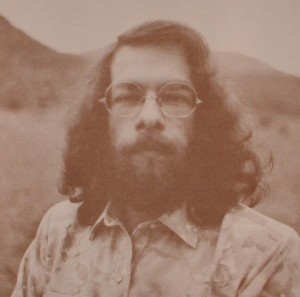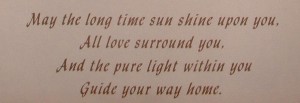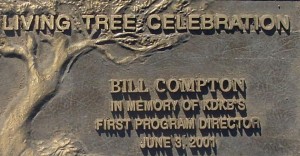Originally from Texas, William Edward Compton’s impact on radio began in 1969 when, with only 5 years of radio experience under his belt, he set out for Los Angeles. It is our fortune that he only got as far as Phoenix.
 In 1969 Phoenix Top Forty AM Radio ruled the dial. Rival stations KRIZ and KRUX were locked in a continual battle to be number one. In the late 1960’s, hoping to win the ratings war, KRUX took a chance on Bill Compton. That’s when Compton began forging his own path to fame.
In 1969 Phoenix Top Forty AM Radio ruled the dial. Rival stations KRIZ and KRUX were locked in a continual battle to be number one. In the late 1960’s, hoping to win the ratings war, KRUX took a chance on Bill Compton. That’s when Compton began forging his own path to fame.
KRUX took a bold step for a Top 40 station when they hired him to host a new, ‘open format’ music show, something nonexistent on the dial. With Compton in charge suddenly something different began happening on the radio. Every Sunday night, using the on-air name “Little Willie Sunshine,” Compton brought KRUX head long into the ‘Age of Aquarius’ with his engagingly diverse sets. Rock, folk, jazz, R&B, blues – simply any music that spoke to him came floating through the airwaves.
But at KRUX, his open format radio was only a hint of what Compton wanted it to be. So he grabbed an opportunity to become program director for a little 500-watt daytime only AM radio station called KCAC. First, KCAC broadcast out of what would now be known as a ‘historic house’ on Camelback Road, between 7th and 15th Avenues. The presence of a bunch of hippies running a radio station not far from quiet family streets ruffled some feathers.
One day Compton walked into his station to find that KCAC had been burglarized. The station’s library of LP’s had disappeared. He appealed to his listeners to loan the station records while KCAC rebuilt its library. In no time, the faithful were streaming in to the little brown house, balancing their unwieldy stacks of LPs. The station happily accepted listener’s LP’s and offered ‘herbal compensation’ to those who came to the rescue.
KCAC later moved from the house on Camelback to inside a big music store housed in Tower Plaza, near 40th Street and Thomas. At that location, Compton broadcast live from the display window of Wallich’s Music City. The booth faced a sidewalk filled with curious teens, inspired listeners and anyone else who happened by. That kind of set up would probably result in chaos today, but Compton already had a reputation as one of a kind, Arizona’s musical pied piper. Compton respected his listeners and received nothing less in return.
Broadcasting from Wallich’s had another big upside. Compton had access to all kinds of albums and undoubtedly was partly responsible for the store’s great selection of records. At Wallich’s, would be customers were invited to listen to records before buying them. If the store didn’t have an “open copy” they’d open one. Customers were shown to glass enclosed “listening booths” where they lovingly placed records on the turntable and decided if they liked them enough to buy them.
By l971, KCAC was in financial straits, so Bill Compton joined forces with Valley newcomer Dwight Tindle, who formed “Dwight Karma Broadcasting.” On August 23, l971, KDKB and Compton signed on, broadcasting from a two story red brick building on Country Club and First Avenue in Mesa. Tindle recognized exceptional talent and as the station’s first program director Compton had free reign to create a radio station that would transform the dial.
Compton told his hand picked crew of passionate music connoisseurs to do their own thing. And they did. KDKB (affectionately called ‘Krazy Dog Krazy Boy radio’) regularly featured local artists performing live, in-studio. Compton played their records; he was a tireless champion of the music scene. KDKB even made a yearly “Arizona Sounds” compilation of local music that was culled from hundreds of band tapes.
KDKB listeners always knew they had a surprise or two in store for them. On the air there were hilarious live comic sketches, ad promotions for non-existent products and services, and award winning radio commercials that were created in house.
A riotously fictitious ad campaign for the “First Women’s National Credit and Trust Bank,” (“run by and for women only!”) landed KDKB in lots of hot water. The station received a “cease and desist” letter from the state warning them to end the promotion. The Arizona State Fiduciary Board feared listeners might expect a branch to “open soon near them.”
The fake bank’s ads promised ‘interest free car loans for women,” and “free sperm from the bank’s own sperm bank” for women who opened accounts. Calls from women lit up the KDKB telephone lines asking when the bank would open its doors.
The station also broadcast “The Love Workshop,” a “radio theatre” segment known for its peculiar trademark of tasteless hilarity. There were no sacred cows at KDKB. 93.3 FM became a kind of pulpit, preaching fun and the musical dogma of the cutting edge. One of the sketch writers even landed a job at the irreverent, iconic National Lampoon Magazine.
Compton generated listeners for nationally touring acts like Jerry Riopelle, Buckingham Nicks, Bruce Springsteen and Van Morrison, among others. Compton’s support affected the careers of Stevie Nicks and John Stewart, who is best known for a hit record with Stevie Nicks (made after the release of Stewart’s many critically acclaimed solo albums.)
It is next to impossible to pare down a biography about William Edward Compton. When you talk to people who knew Bill Compton you know you missed something that won’t ever again happen in radio. A picture emerges of a man whose beliefs in the power of music, community action, tolerance and non-violence were evident in the way he lived his life on and off the air.
For example, under his charge, KDKB featured comprehensive daily fifteen-minute newscasts, and a weekly show devoted to political and social issues, Valley culture, music and arts. In addition to his stewardship of KDKB, Compton was an ordained minister of the Universal Life Church, occasionally performing marriage ceremonies.
Music lovers and musicians both locally and nationally are forever in Compton’s debt. Compton turned the Valley from a ‘cow town’ into a ‘cool town’ with his visionary approach to radio, along with his laid back, unpretentious personality.
Born in Tyler, Texas in 1945, his vision for Valley radio was cut off in its prime on June 21, 1977 when William Edward Compton swerved to avoid a bicyclist on Osborn Road in Phoenix. He died instantly. After his death, a large site adjacent to Legend City was used to build a concert amphitheatre. Jess Nicks, Stevie’s father, was an owner of the venue. It was named “Compton Terrace.”

Mariah Fleming
Music & More Arizona

